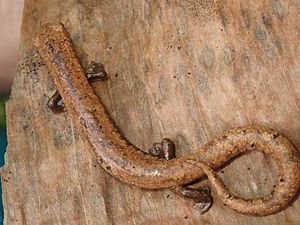Camron climbing salamander facts for kids
Quick facts for kids Camron climbing salamander |
|
|---|---|
 |
|
| Conservation status | |
| Scientific classification | |
| Synonyms | |
|
The Camron climbing salamander (Bolitoglossa lignicolor) is a fascinating creature. It is also known as the Camron mushroomtongue salamander or wood colored salamander. This small animal is a type of salamander from the family Plethodontidae.
You can find this special salamander in the warm, wet forests of Costa Rica and Panama. It loves places with lots of moisture, like subtropical or tropical lowland forests. Sadly, its home is shrinking because of habitat loss. This means it is a species that needs our help to survive.
Contents
What is a Salamander?
Salamanders are amazing amphibians. This means they can live both on land and in water. They are related to frogs and newts. Most salamanders have four legs, a long tail, and moist skin. They need to keep their skin wet to breathe!
Breathing Without Lungs
Many salamanders, including the Camron climbing salamander, are part of the Plethodontidae family. These salamanders are special because they do not have lungs! Instead, they breathe through their skin and the lining of their mouth. This is why they must always stay in damp places.
Where Does it Live?
The Camron climbing salamander lives in Central America. Its main homes are in the countries of Costa Rica and Panama. These areas are known for their rich biodiversity.
Its Forest Home
This salamander prefers tropical moist lowland forests. These forests are warm and rainy all year round. They have many tall trees and a thick layer of leaves on the ground. This environment provides the perfect damp conditions for the salamander to thrive. It also offers plenty of places to hide and find food.
What Does it Look Like?
The Camron climbing salamander is usually small. Its body is designed for climbing. It has a special tongue that can shoot out to catch insects. This is why it is sometimes called a "mushroomtongue" salamander.
Its Unique Tongue
The "mushroomtongue" name comes from its unique tongue. It is shaped like a mushroom and can extend very quickly. This helps the salamander grab tiny insects and other small creatures to eat. It is a very effective hunting tool!
Why is it Called "Climbing"?
This salamander is known as a "climbing" salamander for a good reason. It spends a lot of its time climbing on trees and plants. Its body and feet are adapted to help it grip surfaces. This allows it to move easily through the forest canopy.
Life in the Trees
Living in trees helps the salamander find food. It also helps it avoid predators on the forest floor. Its ability to climb makes it a unique part of the forest ecosystem.
Why is it Threatened?
The biggest threat to the Camron climbing salamander is habitat loss. This means that the places where it lives are disappearing.
Causes of Habitat Loss
- Deforestation: Forests are cut down for farming, logging, or building. This removes the trees and plants the salamander needs.
- Climate Change: Changes in weather patterns can make its habitat too dry. This is dangerous for an amphibian that needs moist skin.
- Pollution: Chemicals from farms or industries can harm the water and soil. This makes the environment unsafe for salamanders.
What Can We Do to Help?
Protecting the Camron climbing salamander is important. We can help by supporting efforts to save its forest home.
Conservation Efforts
- Protecting Forests: Supporting organizations that work to stop deforestation.
- Sustainable Practices: Encouraging ways of living that do not harm the environment.
- Learning More: Educating ourselves and others about these amazing animals.
Every small action can make a difference in protecting species like the Camron climbing salamander.
See also
In Spanish: Bolitoglossa lignicolor para niños
Images for kids



